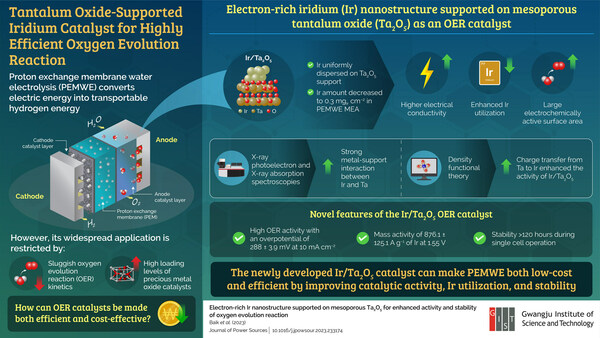
Gwangju Institute of Science and Technology Researchers Design Efficient Iridium Catalyst for Hydrogen Generation
Published by Todd Bush on August 18, 2023
The designed iridium nanostructure, supported on mesoporous tantalum oxide, enhances electrical conductivity, catalytic activity, and long-term stability
GWANGJU, South Korea , Aug. 16, 2023 /PRNewswire/ -- The energy demands of the world are ever increasing. In our quest for clean and eco-friendly energy solutions, transportable hydrogen energy offers considerable promise. In this regard, proton exchange membrane water electrolyzers (PEMWEs) that convert excess electric energy into transportable hydrogen energy through water electrolysis have garnered remarkable interest. However, their widescale deployment for hydrogen production remains limited due to slow rates of oxygen evolution reaction (OER) – an important component of electrolysis – and high loading levels of expensive metal oxide catalysts, such as iridium (Ir) and ruthenium oxides, in electrodes. Therefore, developing cost-effective and high-performance OER catalysts is necessary for the widespread application of PEMWEs.

Researchers from Korea and USA develop a novel iridium catalyst with enhanced oxygen evolution reaction activity, facilitating a cost-effective proton exchange membrane water electrolysis for hydrogen production.
>> In Other News: Fusion Fuel Submits Three Green Hydrogen Projects to Spanish H2 Pioneers II Program
Recently, a team of researchers from Korea and USA, led by Professor Chanho Pak from Gwangju Institute of Science and Technology in Korea, has developed a novel mesoporous tantalum oxide (Ta2O5)-supported iridium nanostructure catalyst via a modified formic acid reduction method that achieves efficient PEM water electrolysis. Their study was made available online on May 20, 2023 and will be published in Volume 575 of the Journal of Power Sources on August 15, 2023. The study was co-authored by Dr. Chaekyung Baik, a post-doctoral researcher at Korea Institute of Science and Technology (KIST).
"The electron-rich Ir nanostructure was uniformly dispersed on the stable mesoporous Ta2O5 support prepared via a soft-template method combined with an ethylenediamine encircling process, which effectively decreased the amount of Ir in a single PEMWE cell to 0.3 mg cm–2," explains Prof. Pak. Importantly, the innovative Ir/Ta2O5 catalyst design not only improved the utilization of Ir but also facilitated higher electrical conductivity and a large electrochemically active surface area.
Additionally, X-ray photoelectron and X-ray absorption spectroscopies revealed strong metal–support interaction between Ir and Ta, while density functional theory calculations indicated a charge transfer from Ta to Ir, which induced the strong binding of adsorbates, such as O and OH, and maintained Ir (III) ratio in the oxidative OER process. This, in turn, led to the enhanced activity of Ir/Ta2O5, with a lower overpotential of 0.385 V compared to a 0.48 V for IrO2.
The team also demonstrated high OER activity of the catalyst experimentally, observing an overpotential of 288 ± 3.9 mV at 10 mA cm−2 and a mass activity of 876.1 ± 125.1 A g−1 of Ir at 1.55 V, significantly higher than the corresponding values for Ir Black. In effect, Ir/Ta2O5 exhibited excellent OER activity and stability, as further confirmed through membrane electrode assembly single cell operation of over 120 hours.
The proposed technology offers the dual benefit of reduced Ir loading levels and an enhanced OER efficiency. "The improved OER efficiency complements the cost-effectiveness of the PEMWE process, enhancing its overall performance. This advancement has the potential to revolutionize the commercialization of PEMWEs, accelerating its adoption as a primary method for hydrogen production," speculates an optimistic Prof. Pak.
Together, this development takes us one step closer to achieving a sustainable transportable hydrogen energy solution and, in turn, carbon neutrality.
Reference
Title of original paper: Electron-rich Ir nanostructure supported on mesoporous Ta2O5 for enhanced activity and stability of oxygen evolution reaction
Journal: Journal of Power Sources
DOI: https://doi.org/10.1016/j.jpowsour.2023.233174
About the Gwangju Institute of Science and Technology (GIST)
http://www.gist.ac.kr/
SOURCE Gwangju Institute of Science and Technology (GIST)
Subscribe to the newsletter
Daily decarbonization data and news delivered to your inbox
Follow the money flow of climate, technology, and energy investments to uncover new opportunities and jobs.
Latest issues
-
SAF Output Doubled, So Why Is IATA Sounding Alarms?
Happy New Year from Decarbonfuse! As we wrap up 2025, we want to thank you for being part of the growing Decarbonfuse community. Your engagement and feedback have helped make this platform a trust...
-
$213 Per Tonne: Inside the Latest Multi-Pathway CDR Deal
Inside This Issue 💸 $213 Per Tonne: Inside the Latest Multi-Pathway CDR Deal 🏛️ Clean Energy Technologies Affiliate Vermont Renewable Gas Advances Regulatory Review 💧 Fusion Fuel’s BrightHy Soluti...
-
The Three-Continent Move That Redefines SAF
Wishing everyone a restful holiday season.🎄🎅🎁 Inside this Issue ✈️ Cathay Goes Global With SAF in Three-Continent Fuel Deal 🧪 Proton Ventures Partners With Barents Blue For Realization Of The Bar...
Company Announcements
-
HyOrc Completes Factory Acceptance Test of 500kW ORC Turbine for International Customer
HOUSTON, Dec. 31, 2025 (GLOBE NEWSWIRE) -- HyOrc Corporation (OTCID: HYOR), a clean-energy technology company, today announced the successful completion of the Factory Acceptance Test (FAT) for its...
-
Nova Sustainable Fuels Receives Approval to Produce Sustainable Aviation Fuel in Guysborough County
Nova Sustainable Fuels has received environmental assessment approval for the first phase of a project that will see the company develop a renewable energy park in Goldboro, Guysborough County, whe...
-
Darling Ingredients Announces Sale of Approximately $50 Million in Production Tax Credits
IRVING, Texas -- Darling Ingredients Inc. (NYSE: DAR) today announced the sale of approximately $50 million of production tax credits to a corporate buyer. These credits were generated under the In...
-
Aemetis Receives Funds From the Sale of $17 Million of Federal Clean Energy Tax Credits
CUPERTINO, Calif., Dec. 30, 2025 (GLOBE NEWSWIRE) -- Aemetis, Inc. (NASDAQ: AMTX), a renewable natural gas and renewable liquid fuels company focused on lower cost and reduced emissions products, t...